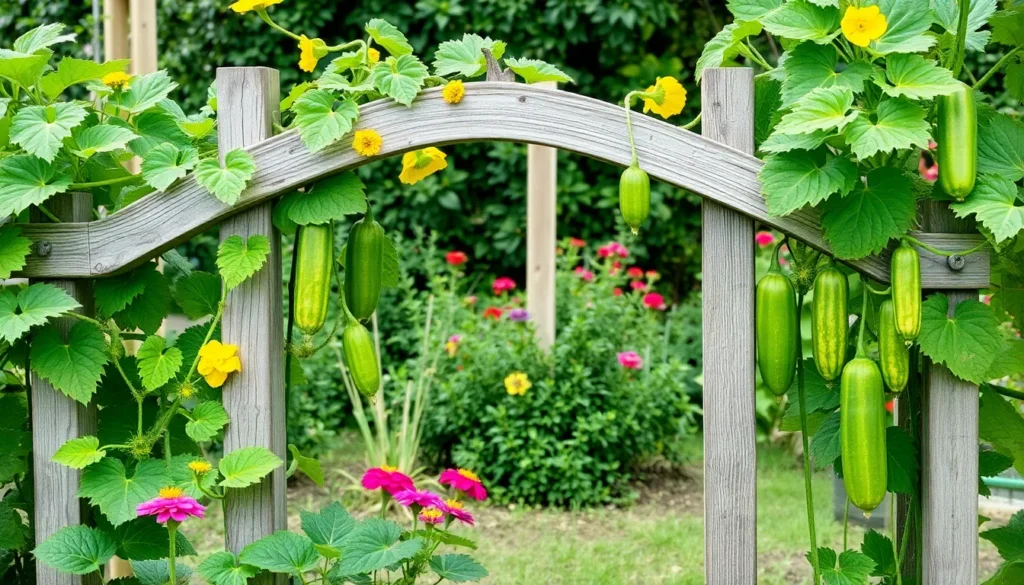There’s something truly magical about watching cucumber vines stretch and spiral their way up a trellis, transforming a simple structure into a lush, green tapestry. Whether you’re just starting your gardening journey or have soil-stained hands from years of experience, growing cucumbers vertically is a rewarding endeavor that maximizes space while offering a bounty of crisp, delicious produce.
For the novice gardener, trellising cucumbers can simplify the sometimes daunting task of managing a sprawling plant. It keeps your garden neat and organized, making it easier to spot pests and diseases before they become a problem. Seasoned gardeners, on the other hand, will appreciate the improved air circulation and ease of harvest that a trellis provides, enhancing both the health and yield of your cucumber crop.
In this article, we’ll explore the ins and outs of successfully growing cucumbers on a trellis, from selecting the right varieties to understanding the nuances of guiding your vines skyward. You’ll learn practical tips and tricks to ensure your cucumber plants thrive, making the most of your gardening space. With our guidance, you’ll be well-equipped to embrace the joy of vertical gardening and enjoy the freshest cucumbers right from your own garden.
Select a Suitable Trellis Type
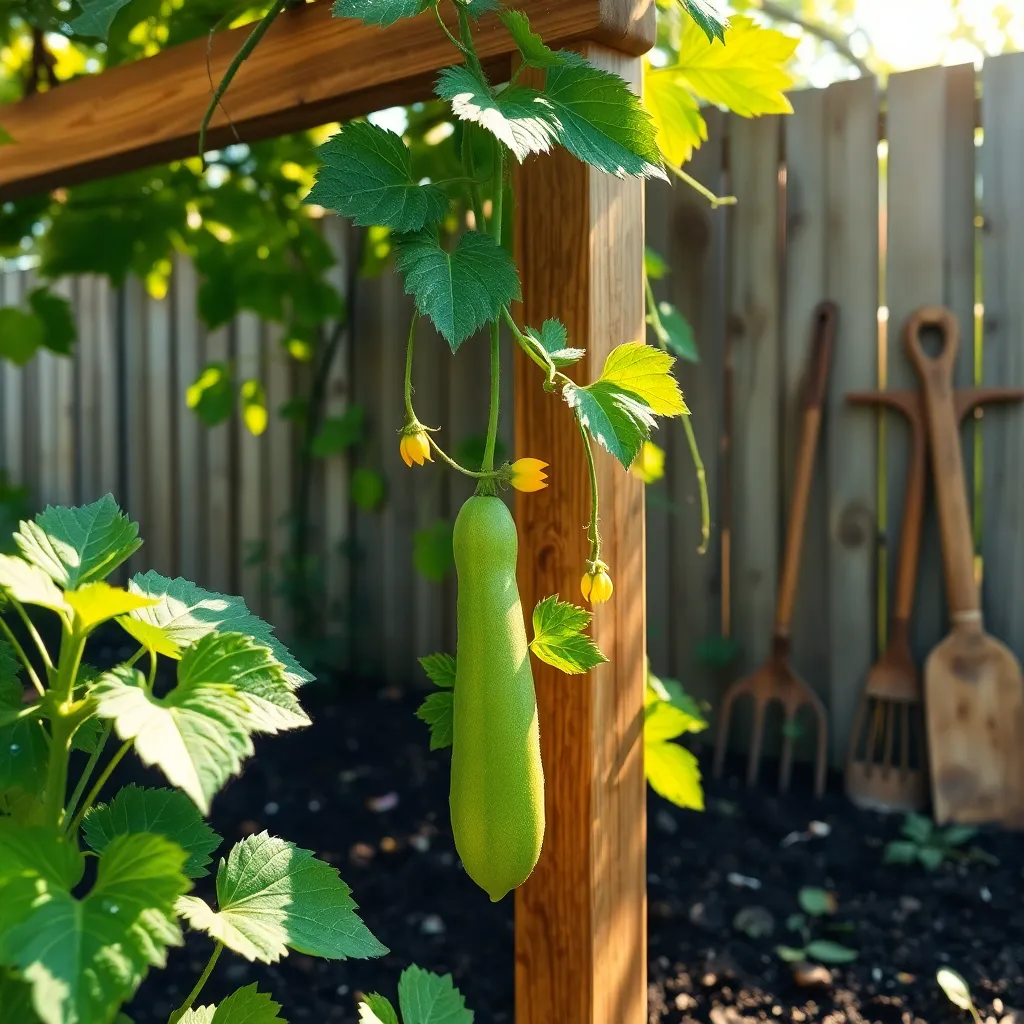
When selecting a trellis for your cucumbers, consider the space available and the specific variety of cucumber you are growing. A-frame trellises are excellent for smaller gardens as they provide vertical support and maximize space efficiently.
Another popular option is a vertical trellis, which is ideal for larger gardens and can support heavy fruit loads. This type of trellis allows cucumbers to hang freely, promoting better air circulation and reducing the risk of fungal diseases.
For gardeners seeking a more natural look, teepee-style trellises made from bamboo or wooden stakes can be both functional and aesthetic. They are easy to construct and can be customized in height to accommodate different cucumber varieties.
Regardless of the type of trellis, ensure it is sturdy enough to support the weight of mature plants and their fruit. Secure your trellis firmly into the ground, especially if you live in an area prone to strong winds.
Prepare Soil and Plant Seeds
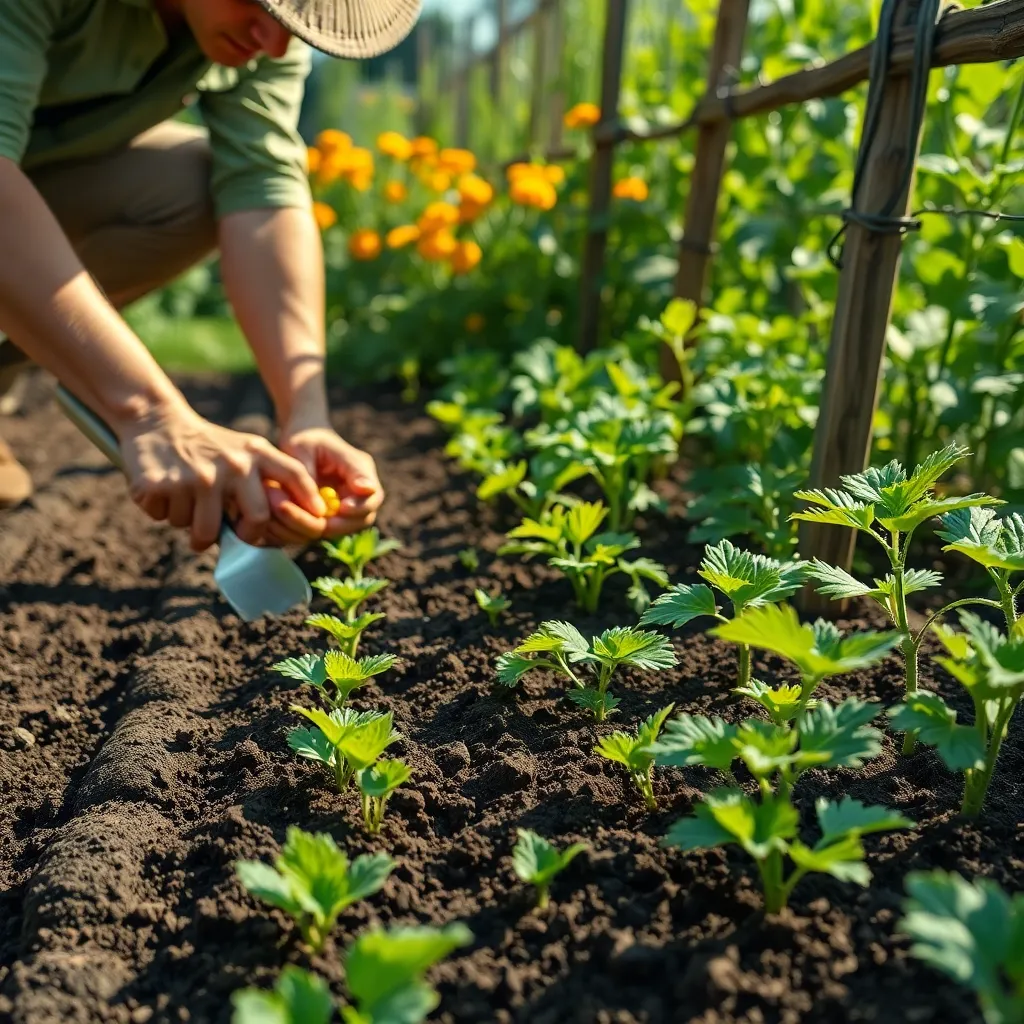
To begin growing cucumbers on a trellis, it’s essential to prepare the soil thoroughly. Start by choosing a well-draining, fertile spot where cucumbers will thrive; cucumbers prefer loamy soil with a pH between 6.0 and 6.8.
Enhance your soil by incorporating organic matter such as compost or aged manure. This will not only improve soil structure but also provide the necessary nutrients for vigorous cucumber vines.
Once your soil is ready, it’s time to plant the cucumber seeds. Sow the seeds about 1 inch deep and 12 inches apart to give each plant enough space to grow and access sunlight efficiently.
For best results, consider sowing seeds directly into the garden after the last frost date in your area. If you prefer an early start, you can plant seeds indoors in biodegradable pots two weeks before transplanting them outside.
Water the seeds gently but thoroughly after planting. During the growing season, cucumbers require consistent moisture, so ensure the soil remains evenly moist but not waterlogged to prevent root rot.
Mulching around the base of the plants can help retain soil moisture and suppress weeds. Use organic mulch like straw or shredded leaves to create a healthy growing environment for your cucumbers.
Train Vines onto the Trellis
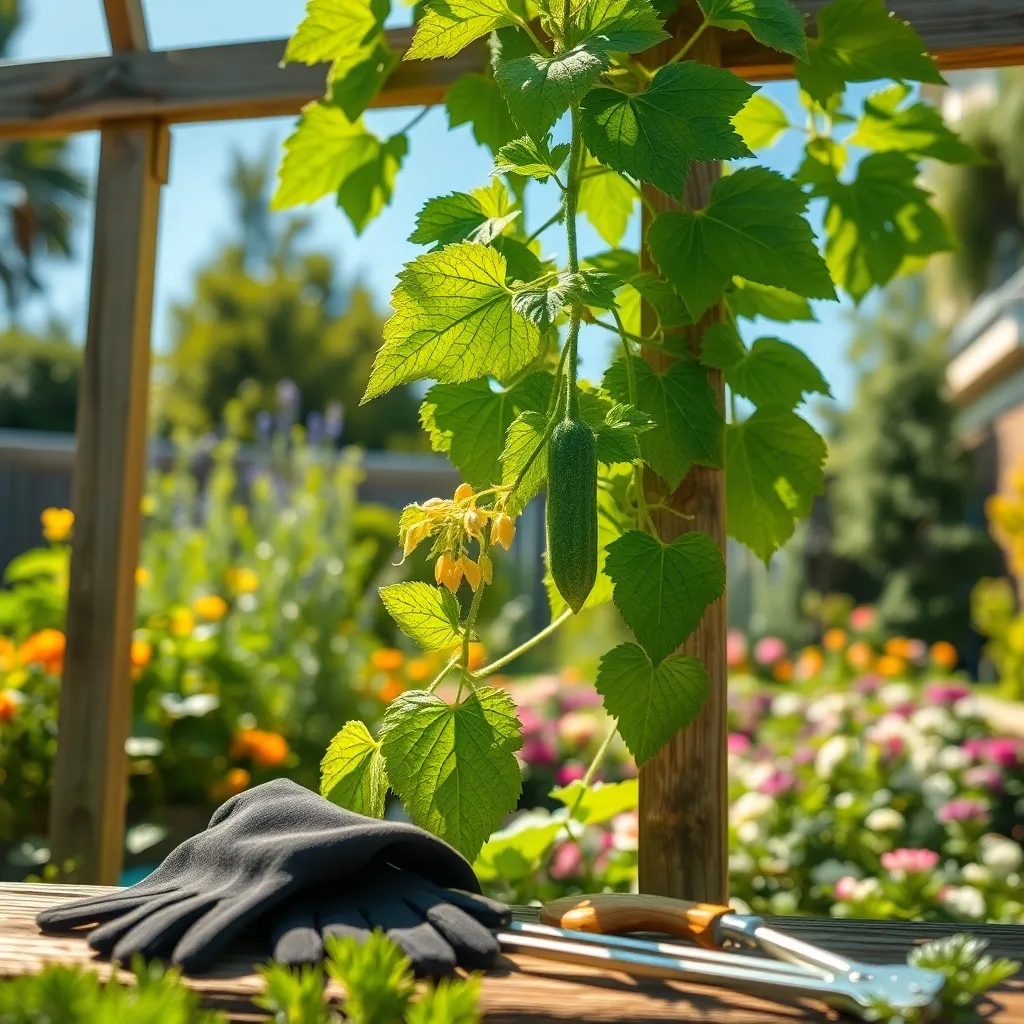
Once your cucumber seedlings are a few inches tall, it’s time to start training them onto the trellis. Begin by gently guiding the main vine towards the trellis, using soft plant ties if necessary to secure it without damage.
It’s important to regularly check the vines as they grow to ensure they are attaching properly. As the cucumber plants develop, you can help them by weaving the vines through the trellis openings, which provides additional support.
For best results, ensure the trellis is sturdy enough to support the weight of mature cucumber plants. Materials like wood or metal are ideal because they provide strong support, especially during fruiting when the plants become heavier.
Watering plays a crucial role in maintaining healthy vines, so keep the soil consistently moist but not waterlogged. Cucumber roots prefer well-draining soil, so if you’re using containers, make sure they have adequate drainage holes.
Additionally, consider using a mulch layer around the base of your plants to retain soil moisture and suppress weeds. This not only benefits the cucumber plants but also reduces the frequency of watering, especially during hot weather.
Water Consistently for Growth

Ensuring consistent watering is crucial for the healthy growth of cucumbers on a trellis. Cucumbers need about an inch of water per week, so it’s essential to establish a regular watering schedule.
Early mornings are the best time to water, as they allow the plants to absorb moisture before the heat of the day. Deep watering encourages root development, helping your cucumber plants access nutrients and moisture more efficiently.
It’s important to keep the soil consistently moist but not waterlogged. To check soil moisture, insert your finger about an inch into the soil; if it feels dry, it’s time to water.
Mulching around your cucumber plants can help retain moisture and reduce the frequency of watering. Organic mulches like straw or shredded leaves work well, as they also enrich the soil as they decompose.
Monitor and Harvest Regularly
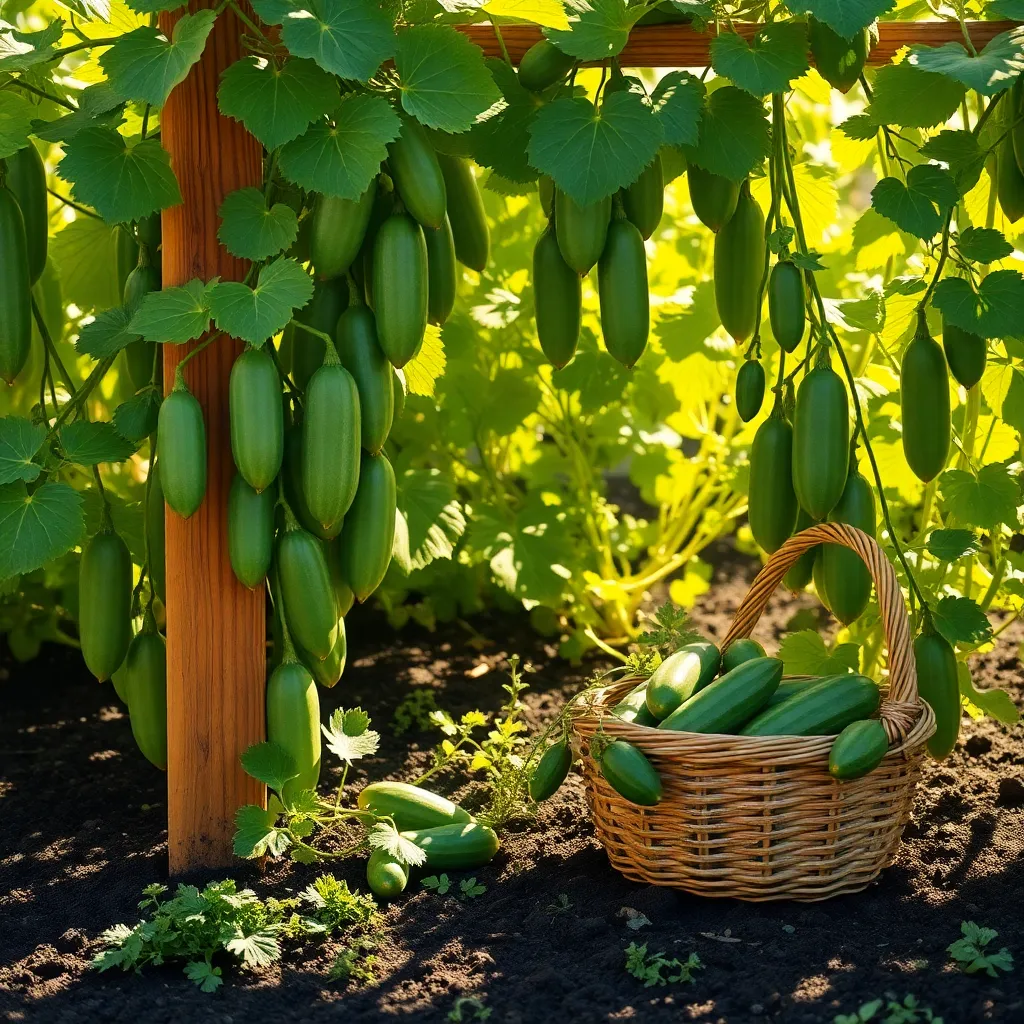
Regular monitoring of your cucumber plants is essential to ensure they remain healthy and productive throughout the growing season. Check your trellised plants at least twice a week for signs of pests, diseases, and nutrient deficiencies, addressing any issues promptly to prevent them from escalating.
Observing changes in leaf color or shape can provide early warnings of nutritional needs. Yellowing leaves may indicate a nitrogen deficiency, so apply a balanced fertilizer to give your cucumbers the nutrients they need for vigorous growth.
Cucumbers grow rapidly and can become overripe if not harvested in a timely manner. Pick cucumbers when they reach the desired size—usually 6 to 8 inches for slicing varieties—to ensure they are tender and flavorful.
Using a sharp knife or pruning shears, cut the cucumbers from the vine to avoid damaging the plant. Harvesting regularly encourages more production, as cucumbers left on the vine can signal the plant to slow down fruiting.
For gardeners with experience, consider leaving some cucumbers to mature fully to collect seeds for future planting. Allow them to turn yellow and harden before harvesting, then scoop out the seeds, rinse, and let them dry thoroughly before storage.
Conclusion: Growing Success with These Plants
In “How to Grow Cucumbers on a Trellis,” we’ve explored five essential relationship concepts: the importance of establishing a sturdy foundation, nurturing growth through consistent care, providing support and guidance as your relationship climbs, recognizing when to prune for healthier interactions, and celebrating the fruits of your shared efforts. These principles not only apply to cultivating cucumbers but also to nurturing the bonds that matter most in our lives.
To put these concepts into action, choose one area of your relationship that might benefit from a bit more attention. Whether it’s scheduling regular quality time together or communicating more openly, taking the first step today can make a world of difference.
Remember, relationships, like gardens, thrive when tended to with love and dedication. Bookmarking this article will ensure you have a trusted resource to revisit as you continue your journey towards a flourishing partnership. As you nurture your relationship with intention and care, you lay the groundwork for lasting success and happiness. Embrace the journey ahead with confidence, knowing that each small effort contributes to a more vibrant and resilient connection.

